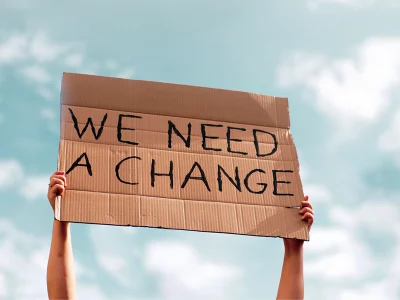

Social Context of the Law: Environmental Law: Regulation and the Right to Protest
Taken from a panel discussion held on 15 October 2024, between Master Stephen Simblet and Sudhanshu Swaroop KC, moderated by Master Saira Kabir Sheikh.
Saira Kabir Sheikh KC: Climate change and environmental catastrophe are real and pressing issues. They are the issues of today. But there is nonetheless a view that protests need to be within the boundaries of the law and to respect the rights of others who are also entitled to exercise the rights that have been given to them in a democratic society.
We’re going to explore some of the recent decisions of the civil and criminal courts, talk about Articles 10 and 11 of the European Convention on Human Rights (ECHR), and look at the way they’ve been dealt with by the courts.
Stephen Simblet KC: The first thing to say is that very few of the rights and freedoms that we all enjoy would have occurred without some form of disruptive protest. Magna Carta was the product of armed confrontation between the King and the barons. We’re sitting in The Inner Temple, one of the places stormed by Wat Tyler in the Peasants’ Revolt, where it was burned. Subsequently, the serfs gained more freedom, the Poll Tax was abolished and we didn’t have another Poll Tax introduced until Margaret Thatcher tried in 1990, resulting in a series of demonstrations and protests, and the Poll Tax was defeated.
The planning for this talk took place in the Gandhi Room, which is a room commemorating a man disbarred by The Inner Temple for his actions campaigning successfully for the independence of India by disruptive protest.
Even basic democratic rights, such as voting, came about through disruptive protest. The extension of the franchise introduced in the Reform Act 1832 followed riots across England in 1831, and it’s only just over 100 years since women have had the vote. The suffragettes had a window-smashing campaign, and they also disrupted sporting events. Everyone has heard of Emily Davison throwing herself under the King’s horse at the Epsom Derby. The suffragettes also attacked perceived male environments, such as football grounds and golf courses, where they replaced flags with suffragette colours or carved messages in the greens, damaging them. There was similar disruption to sporting events, including rugby and cricket Test matches, in the 60s and 70s by anti-apartheid protesters.
Those things were all hated at the time, just as Just Stop Oil throwing orange dust over the snooker tables at the Crucible in the World Snooker Championship got the same sort of criticism. But sitting here now, who would say women shouldn’t have the vote, or that a country that categorises people by race and prevents the majority of its population from having any sort of rights should be welcome in the UK? But those positions came about, in large part, not through cases brought in the courts, but through disruptive protest. It’s in that context, I say, that we should be considering climate change and environmental catastrophe as real and pressing issues. The question is whether, and to what extent, the law corresponds to what is just.
Over five years ago, the House of Commons unanimously passed a motion declaring a climate emergency. We sit here in 2024 still facing that climate emergency. Some would say that very little of substance has changed, and it is largely by protest that things will be changed. When the Human Rights Act 1998 came into force in 2000, there was something of a heyday about protesters’ rights being perhaps respected more in the courts; the balance being struck now, post-2022 is quite different.
Article 10 gives you the right to freedom of speech, and interference with that can only be done for a range of very limited exceptions. Article 11: Freedom of Association. Those are important things, because, from a protest point of view, the difference between a crank with a one-person campaign and a real social movement is numbers.
When we’re looking at how protest rights are to be considered and what legal limits should be imposed on these, we have to bear in mind that the symbolism of a protest and the numbers of a protest are what’s important, not just what is said. In a case from 2007, R (Tabernacle) v Secretary of State for Defence, a protest to challenge the existence of byelaws prohibiting access to land outside the Aldermaston base – where the purpose of the byelaws was to deter protests – failed at first instance but succeeded in the Court of Appeal. Lord Justice Laws, the year before he became Treasurer of this Inn, said, “Rights worth having are unruly things, demonstrations and protests are liable to be a nuisance. Sometimes they betray a kind of arrogance, an arrogance which assumes that spreading the word is always more important than the mess. In that case, firm but balanced regulation may be well justified.”

But over the last decade or so, a number of things have happened that make it harder for protesters to get their message across. It’s not just governments, but private companies that are resorting to the law to try and suppress protests against their activities. Previously, the court would only proceed against named defendants, but that position has changed to allow people to bring proceedings against unnamed defendants. And that provides a very considerable advantage to the claimant. Quite often, they will go ex parte to court, seeking an injunction that affects everybody – essentially now against the whole world – allowing them to construct a case against an entirely theoretical defendant.
In Ineos Upstream Ltd and others v Persons Unknown and others, the claimants proceeded in secret because they didn’t want to tip off the defendants. They didn’t inform the court at the interim injunction hearing that the claim involved the Human Rights Act, and, in respect of the human rights arguments, relied on a case which held that Article 10 was not, of itself, a defence to someone squatting in a building as part of a protest against possession proceedings. They were seeking extremely wide-ranging and draconian injunctions. It had a vast effect on all sorts of people involved, stayed in place in its entirety over four months and most of it was discharged by the Court of Appeal in 2019, over two years after it had been brought.
People opposing injunctions take on a very considerable risk to themselves. It’s worth remembering that these injunctions bind us all. You may not know that you’re the potential defendant to an injunction brought by Transport for London, but there are currently injunctions in place all around various sites in London, and they have been brought mainly with the support and encouragement of energy companies, because it’s in their interests for protests to be deterred.
The fact an injunction is sought against the world is a real, current and practical problem. These injunctions are often sought on a quia timet basis before anything has happened, and therefore the court, on an ex parte hearing, is unlikely to be able to pay much attention to the weight of the real threat or the weight of the contrary evidence, even on the relatively relaxed test that’s being brought.
An injunction is a serious thing. There are draconian penalties for breaching one. You could be sent to prison. You’re liable to incur extensive financial penalties through fines and costs orders, and that can happen without you having been involved in the proceedings at all in the first place.
In the Public Order Act 2023, there are now specific criminal offences relating to tunnelling and locking on. You might understand why those might be specific offences, as well as obstructing major transport works, and interference with key national infrastructure. But the definition of ‘national infrastructure’ covers any A or B road. So if you do something that goes beyond the bounds of reasonable use of the road, you are committing an offence for which you could go to prison for a year.
Although it used to be the case that the law treated protesters less harshly because of the intent behind the protests, that has very specifically been changed, both by parliament and by recent sentencing decisions in the Court of Appeal.
Rights worth having are unruly things, demonstrations and protests are liable to be a nuisance. Sometimes they betray a kind of arrogance, an arrogance which assumes that spreading the word is always more important than the mess. In that case, firm but balanced regulation may be well justified.
Sudhanshu Swaroop: My expertise is in climate law, particularly in recent test cases that have taken place at the international level.
My contention today is that, on questions of climate protest, the English courts are entitled to – and should – take account of wider developments in the law and practice of climate change.
I will start with the human rights framework in which protest cases are decided. The courts must first consider whether a restriction on the protest, such as an injunction, is consistent with Articles 10 and 11 of the ECHR. The question arises most obviously in the context of injunction cases, but it can also arise in the criminal context, where there is a defence of ‘lawful excuse’.
Generally, the courts accept that measures such as injunctions do restrict protesters’ Article 10 and Article 11 rights. The question then is whether that restriction can be justified as being “necessary in a democratic society” under Articles 10.2 and Article 11.2. In this regard, the courts must decide where a fair balance is to be struck between the legitimate aim of the prevention of disorder and the protection of rights and freedoms. Thus, the court must engage with the question of proportionality.
The leading case is the 2021 Supreme Court judgment in Director of Public Prosecutions v Ziegler and others, where the defendants were being prosecuted for causing a road to be closed during a protest against an arms fair that was taking place at a nearby conference centre. The court observed that proportionality is a fact-specific inquiry. Lord Hamblen and Lord Stevens said it is relevant whether the defendant believed in the views they were expressing, and furthermore: “It is also appropriate to take into account the general character of the views whose expression the convention is being invoked to protect. Political views, unlike tittle tattle, are particularly worthy of protection.”
In my view, when it comes to climate change, the relevant facts and the relevant general character of the views in question should be determined not just by asking the general question “are these political or not?”, but by considering wider developments taking place in relation to climate law. These developments show that the views of climate protesters, to a significant extent, are not just ‘views’, but matters of undisputed fact or matters of opinion that have been universally endorsed – not just by scientists, but by almost every state in the world. I draw attention to four particular developments.
First, there is the Paris Agreement, which was adopted in 2015 by over 190 states, and which is the cornerstone of international climate law. The preamble of the treaty expressly refers to “the urgent threat of climate change.” Thus, the proposition that climate change presents an urgent threat is a view, but it is a view that has been endorsed and recognised in a formal treaty by almost every country on the planet.
The Paris Agreement, which was adopted in 2015 by over 190 states … is the cornerstone of international climate law.
Secondly, the parties to the Paris Agreement have agreed a temperature goal, as set out in Article 2, namely “Holding the increase in the global average temperature to well below 2ºC above preindustrial levels, and pursuing efforts to limit the temperature increase to 1.5ºC above preindustrial levels, recognising that this would significantly reduce the risks and impacts of climate change.” There is debate as to the precise legal nature of this provision. But what matters is that almost every state in the world has agreed this goal as part of the response to the urgent threat of climate change.
Thirdly, there is the nature of the scientific consensus as to climate change. In climate litigation, evidence of the causes and effects of climate change is generally based on the reports of the Intergovernmental Panel on Climate Change (IPCC). For example, the IPCC’s 2018 Special Report analysed the effects of climate change on human health if warming exceeds 1.5ºC. Importantly, the IPCC reports are also endorsed by states, as part of a formal process.
Fourthly, there’s the recent European Court decision in the Swiss climate case, KlimaSeniorinnen. An association of senior women from Switzerland argued that their health was being threatened by heatwaves, being made worse by climate change and that accordingly Switzerland was in breach of its Article 2 obligation, the right to life, and Article 8, the right to family and home.
The court found (based inter alia on the IPCC reports that I mentioned) that “there are sufficiently reliable indications that anthropogenic climate change exists and that it poses a serious current and future threat to the enjoyment of human rights, under the Convention, that states are aware of it and capable of taking measures to effectively address it” and that “the relevant risks are projected to be lower … if action is taken urgently.”
The court determined that the ECHR should be interpreted in what it called an ‘evolutive manner’. Having regard to the scientific evidence about climate change, it found that there is a legal obligation on states under Article 8 to undertake effective measures to reduce fossil fuel emissions, with a view to reaching Net Zero within three decades. It accepted that states have a margin of appreciation, but this depended inter alia whether a state has complied with its procedural obligations, including that “procedures must be available through which the views of the public, and in particular the interests of those affected or at risk of being affected by the relevant regulations and measures or the absence thereof, can be taken into account in the decision-making process.”
The court determined that the ECHR should be interpreted in what it called an ‘evolutive manner’.
In Shell UK Ltd v Persons Unknown, an application was granted for an injunction to restrain climate change protesters from undertaking activities such as damaging petrol pumps and preventing motorists from entering petrol station forecourts. The court accepted that the injunction interfered with the defendants’ rights under Articles 10 and 11. However, it found the interference was justified, stating that even if there was “an overwhelming global scientific consensus that the business in which the claimant is engaged is contributing to the climate crisis”, this was “not a particularly weighty factor.” That was because, “otherwise judges would find themselves giving greater protection to views which they think important” and it was “not for this court, on this application, to adjudicate on the important underlying political and policy issues raised by these protests, that is for parliament.”
I make the following comments. First, the proposition that there is an overwhelming scientific consensus that the fossil fuel trade contributes to the climate crisis, should arguably not be characterised merely as the ‘views’ of climate protesters, for all of the reasons that I have already set out. Secondly, for the UK courts in climate protest cases to recognise a certain foundation of undisputed fact or scientific consensus would not in itself require them to adjudicate policy issues. Thirdly, the Swiss case raises the question as to whether the ‘evolutive approach’ to interpretation should be applied by English courts in the context of climate protest cases. Fourthly the Swiss case also raises the question as to whether procedural safeguards are relevant to the balancing exercise that the court must perform in climate protest cases. I note that under section 2 of the Human Rights Act the English courts must at least take account of the Swiss case.
English courts should integrate broader developments in climate law and practice which may or may not make a difference on any particular facts.
I am not suggesting that in every single case where an issue of protest arises, the court should automatically refuse an injunction. I recognise that all of these cases are heavily fact-dependent. My point is simply that, in protest cases, English courts should integrate broader developments in climate law and practice which may or may not make a difference on any particular facts.
To conclude, I refer to the 2006 House of Lords judgment in Jones: “My Lords, civil disobedience on conscientious grounds has a long and honourable history in this country. People who break the law to affirm their belief in the injustice of the law, or government action, are sometimes vindicated by history.”
Climate change is a special case because we do not need to await the verdict of history in relation to the matters within our subject of climate protest. We already have the verdict of science, and it is a verdict that has been endorsed by states. It is now open to the courts to endorse that verdict in their judgments.
Stephen Simblet KC
Garden Court Chambers
Sudhanshu Swaroop KC
Twenty Essex
Saira Kabir Sheikh KC
FTB
For the full video recording:
innertemple.org.uk/righttoprotest
